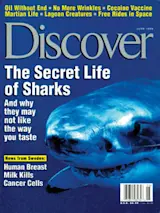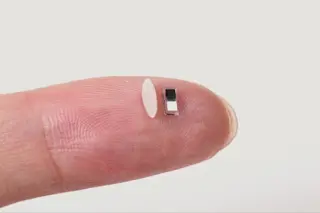The clusters of human skin cells basking in a sterile incubator, with alarms poised to go off if the level of carbon dioxide drops or the temperature wavers from 98.6 degrees, appear to be blessed with eternal youth. Under normal circumstances, skin cells divide about 50 to 70 times and then quickly wither and stop dividing. But after nearly two years in a laboratory at Geron, a Menlo Park, California, biotech company, these genetically altered cells are approaching 400 divisions and still show no signs of aging. They just keep multiplying.
Until now, endlessly multiplying cells indicated one thing: cancer. But Geron biochemist Cal Harley and cell biologist Jerry Shay, who has the same type of lab setup at the University of Texas Southwestern Medical Center in Dallas, say the remarkably youthful skin cells remain cancer-free. Moreover, Harley and Shay hope their success in prolonging the life span of these individual cells in the lab could eventually pave the way for more people to lead healthy and productive lives up to the age of 120. "One of the driving forces for trying to immortalize normal cells is that we may be able to treat or prevent the onset of certain diseases where cell aging plays a key role," says Harley.
He and Shay discovered their cellular fountain of youth when a strand of DNA they inserted into a skin cell prompted the production of telomerase, an enzyme naturally found in very young embryonic cells. Telomerase restores bits of DNA, called telomeres, which cap the ends of chromosomes and keep them from unraveling. Every time a cell divides, its telomeres get shorter, like the burning wick on a candle. When telomeres get down to a critical length, a cell will simply stop dividing. "Telomeres are now known to be the clock of cell aging," says Harley. "Telomerase is the enzyme that can rewind the clock. It gives us a way to restore an increased life span, a youthful life span, to aging cells."
Young cells help keep skin smooth and supple by secreting collagen and elastin, proteins that manufacturers often add to creams and lotions. But when the cells stop dividing, they produce less of these proteins; some make an enzyme that breaks down collagen. As a result, old skin starts looking thin and wrinkled. When cells Harley and Shay had altered began producing telomerase, the effect was remarkable. "Within a few doublings, the telomeres in those cells started to grow, in some cases quite dramatically," says Harley. With their lengthened telomeres, the rejuvenated skin cells also continued to churn out high levels of youthful proteins.
In theory, a skin graft using immortalized cells could replace tough old skin with soft, healthy young skin. A less drastic approach might be to coax skin cells to activate their existing, but dormant, telomerase genes. "It’s a natural gene that’s in every cell but is turned off," says Harley. "You could try to deliver a telomerase activator in a cream," he suggests. "It would penetrate the skin, get into the cells, and keep them from aging."
Harley and Shay hope the beauty of telomerase turns out to be more than skin-deep. One of the most promising potential uses of the enzyme is to treat atherosclerosis, the scarring that blocks arteries. Clusters of eternally youthful endothelial cells, from the protective lining in arteries, are thriving in the Geron lab. These days, when someone undergoes angioplasty to scrape out gunk from clogged arteries, the endothelial lining gets scraped out, too. "Older patients, because of the aging of their endothelial cells, have a reduced ability to heal the wound," says Harley. "If we can deliver rejuvenated endothelial cells, using the same type of balloon catheter that cleans out the vessels, we think we can achieve a permanent solution to the problem."
Harley and Shay are currently working with just a few cell types, but the list of degenerative diseases they eventually plan to target is extensive. In some types of late-onset diabetes, for example, people don’t have enough insulin-making pancreatic islet cells. "What if we could go in with a fine needle, take out one pancreatic islet cell, and introduce telomerase into that cell?" says Shay. "We’d give the person back their own islet cells as if they were from a 20-year-old." Similar procedures could regenerate skin for burn patients, immune cells for people with HIV, retinal cells for blind people, or muscle cells to combat muscular dystrophy. "This is a very potent direction to pursue," says Shay.
Testing these techniques in humans is still a long way off, however. Identifying the best means of triggering a cell to produce telomerase is the first step. Harley and Shay have already had some success engineering viruses to carry telomerase genes, instead of harmful viral genes, into cells. This works fairly well in a petri dish, but when a virus enters a living person, it has to sneak past the body’s defenses to deliver the goods.
Another means of delivery could be to encase telomerase genes in sacs of fatty molecules called liposomes. These tiny sacs fuse with the cells they contact and regurgitate their contents into the cell. "It’s like a tiny bubble fusing into a big bubble," Harley says. Because he has yet to perfect these methods, he’s reluctant to speculate about when people will be able to get telomerase therapy: "I can say we’d be extremely disappointed if it wasn’t in our lifetime."
For the time being, the specter of cancer still hangs over telomerase research. Nearly every type of human cancer cell, instead of aging or dying when its telomeres get short, switches on the gene for telomerase and continues to divide. "We have what appears to be a paradox," says Shay. "Telomerase is on in all cancer cells, yet when we introduce telomerase into normal cells they live forever and there’s no cancer. How do I explain it? Think of the cancer cell as a runaway car. This car has got an accelerator stuck to the floor, your brakes don’t work, the steering wheel comes off, and you’ve got fuel in the gas tank. Think of telomerase as the fuel. We’re born with a full tank of gas. As we age we use up that fuel, and when we’re old we run out of fuel and the car stops moving. Introducing telomerase keeps that car rolling, but it’s not a cancer cell because we’ve still got normal brakes, a fine accelerator, and a steering wheel that works. Just adding telomerase in the absence of other mutations is not going to lead to cancer. If we introduce telomerase into every cell in our bodies, then it very well may be that a few cells have all the other predisposing mutations, and all they lack to be a cancer cell may be turning on telomerase. Therefore it may be permissive for cancer, but it doesn’t cause cancer."
The possibility that telomerase could give an abnormal, mutated cell just the kick it needs to become cancerous means that controlling the effects of any therapy will be critical. "We want to be able to regulate telomerase, to turn it off if need be," says Harley. In the meantime, nearly every type of human cancer cell produces lots of telomerase, which means it could serve as a marker for early detection in people who don’t show obvious symptoms. Bladder cancer, for instance, doesn’t announce itself until blood is found in urine, which is relatively late in the progression of the disease. "It’s been shown that you can detect telomerase by looking at cells in the urine," says Shay. "We might, as part of a checkup, get screened for telomerase."
Ironically, learning how to turn telomerase off may lead to more immediate health advances than knowing how to turn it on. The most urgent task facing Harley and Shay is to develop telomerase inhibitors, molecules that bind to the enzyme and could cause cancer cells to stop replicating. Because of their delayed effect, Shay thinks these inhibitors would be most effective in preventing the deadly relapses that so often occur after standard treatments like chemotherapy and radiation. "All these techniques wind up killing 99.9 percent of cancer cells," he explains, "but if one cell escapes and it keeps dividing, two to five years later it’s going to come back, and it may be resistant to any future treatment. We’re proposing that after surgery, after chemo or radiation, if we now add a telomerase inhibitor for a six-month period, we may prevent or delay that relapse. I think that’s a very exciting possibility."
Harley and Shay both insist that their ultimate concern is the quality of human life, not longevity. "What’s important is not that we live longer but that we have healthier aging," Shay says. "A well-known physician named Ernest Wydner once said that the function of medicine should be to have people die young as late as possible. That’s the concept that drives my way of thinking."














